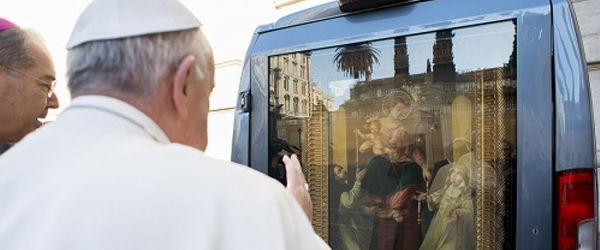Illuminating the End of Time: The Getty Apocalypse Manuscript, with commentary by Nigel J. Morgan.Getty Publications (Los Angeles, 2012). 180 pp., $75.“Illuminating the End of Time" is that rare book that you are welcome to judge by its cover. The beautiful, visually arresting dust jacket alone makes it a coffee-table rock star.
Inside, the facsimile of the Getty Apocalypse Manuscript, with 82 color and 34 black-and-white illustrations, is breathtaking, printed on seriously sumptuous thick paper that feels respectful and appreciative. And yes, you can look at the pictures first. Go ahead, wade through the full color --- replete with glistening gold --- depictions of the fantastic events described in the Bible's Book of Revelation. Enjoy.
Then sit down and do your homework. It's a different book once you know what you're looking at.
When first confronted by the exhaustive commentary on the text and illuminations by Nigel J. Morgan, you might want to throw yourself (and the book) out the window. But don't! The cramped, compact print is hardly "casual reader"-friendly, but making your way through the tight, intense, scholarly history of the Apocalypse books is the key to enjoying this beautiful book from an aesthetic angle. There is context here that you didn't know you needed to know.
Morgan, a fellow of Corpus Christi College at Cambridge, is one of the world's leading authorities on English illuminated manuscripts of the Apocalypse (and how many can there be?). His history and context read like sitting through an entire semester of Father Richard Trame's medieval history class at Loyola Marymount University (Father Trame lectured without notes --- almost without taking a breath --- for the full 50 minutes of every class). But you have the luxury of stopping at any time and referencing the panel(s) you've been reading about. You may be surprised and delighted by what sinks in.
"Illuminating the End of Time" is not "Apocalypse Manuscripts for Dummies." The overall history of these religious manuscripts, comparisons of different styles, texts and illustrations, and the ideas historians have on how and why the similarities and differences are important, can't be absorbed in a scan-through or even a single reading. Morgan writes:
"The Getty Apocalypse stands out as one of the most original interpretations of the illustration of John's visions of its time. It ... expresses the drama of the events of the visions in a special way that sets this book apart among the remarkable series of illustrated Apocalypses created in 13th-century England."
Knowing a little something about the zeitgeist that produced a flurry of apocalyptic manuscripts may not make you an instant hit at cocktail parties, but when you are exposed to a scholar's great love for and knowledge of a subject, it can be a culturally transformative experience.
A brush with greatness can only improve your world, even if that greatness is some 800 years old.
On the other hand, if you just want to look at the pictures, and wonder about the human hands that crafted the lines, the souls who mixed the inks and brushed colorful life into them, you can still get a lot of pleasure from this book. And I hope Morgan will not begrudge you that simpler approach.
At any rate, your coffee table will thank you!
---CNS
Elizabeth Rackover is a freelance writer in southeast Michigan.
{gallery width=100 height=100}gallery/2012/0608/books/{/gallery}

